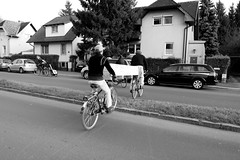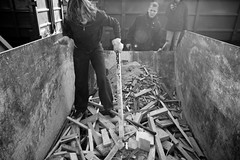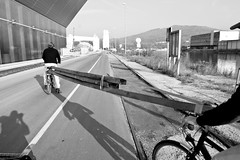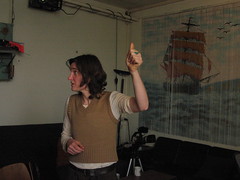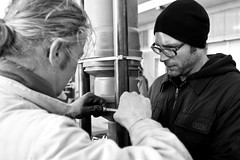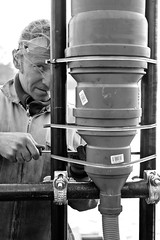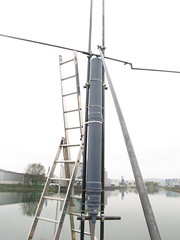Featured pages
Luminous Green 2007
Possible Futures...
Active Discussions...
Table of Contents
Luminous Green Time's Up Style
Day 2 of Luminous Green in Linz
The second day of the Luminous Green workshop at Time's up began with a presentation by Folke Koebberling about using the city as a resource for artistic and architectural projects. The second speaker of the morning was Paul Schausberger, who talked about the industrial and small-scale water filtration - mainly for surface water (e.g. from rivers) and sea water (desalination). The afternoon at the harbour began with lifting up the windmill, testing the pump (albeit with an electromotor, as it's nearly wind still in the harbour at the moment), building the water filter and continuing the hot tub. A small expedition of city-resource finders embarked on an expedition to collect trash for a changing room and a shower (as filtering water for the tub wouldn't make much sense without cleansing the human bodies before they submerge themselves in it…). Already in the industrial zone, they found so much usable material, that they had to come back to the HQ, make a first delivery and then venture further afield. Patrick & Theun conducted a memorable circus act by transporting a 6m piece of wood between two bikes for quite a long distance, across roads, down hills & across construction sites, while yelling “totaal holland!!”. Upon arrival at the harbour at dusk, the duo proceeded to take a fresh dip in the freezing Danube. They, as well as the rest of the half-frozen team warmed up over the delicious concoctions from Marie's kitchen & most of us concluded the day with Theun's birthday cake & copious amounts of wine…
Folke Koebberling
Folke described a work that she and Martin Kaltwasser realised next to the Gropiusstadt in Berlin – first a house, built in 24hrs (Hausbau 04) and later a whole settlement on an empty lot next to the highrises of Gropiusstadt. All material came from the street, as trash from a renovated house in Prenzlauer berg, an increasingly 'fancified' part of Berlin. It took only an afternoon to collect all the materials. The house they built was temporary, perceived almost as a 'fata-morgana' by the inhabitants of the nearby community. The settlement that they built the next year was a slightly longer term project, where it took three months to collect the materials. According to Folke, this was an interesting experiment, but aesthetically not too satisfying – it still had an appearance of a shanty-town.
In one of their following project, they made a replica of an existing 'house of the future (named 'telecom haus') in Berlin. In contrast to the original, the 'Munsterhaus' was open to the public, and rather than being dropped into the neighbourhood, but remaining self contained, this house incorporated elements of its environment, quite literally – it was built in a park, and had a hedge growing straight through it.
Their first work in the rural area was Villa Hoerstel – a house built almost entirely from windows (for walls) and doors (for the roof), as it seemed that the local community had a surplus of both, due to a subsidy regulation, that allowed them to put in new windows cheaply. A part of the house is supported by large trea-trunks, that were collected from a nearby woods (with the permission of the forester) after a large storm blew over several trees.
With their later projects, aesthetics of the buildings is becoming increasingly important – they consider their works constructivist paintings, taking care of colour, texture and composition on all sides of the buildings. Their project 'Amphis' in the Wysing Arts Centre in the UK for example, is a community building, an amphitheatre built out of scrap:
In addition to various community rooms & buildings, Folke & Martin are building several commentaries to the dominating car culture on our streets. In their research they found out that an SUV seen from its side has a very similar layout to a bunker – safe for people inside, absolutely oblivious of events outside. Another piece depicted two SUVs crashing into each other. Another again (just finished in Graz) had repurposed a car to make two fantastic bycicles.
Folke & Martin work with existing structures and materials from film & tv sets, fairs and exhibitions – cultural industries that each city is thriving on. After the events are over, tonnes and tonnes of perfectly reusable material is being thrown onto waste dumps, due to lack of storage and labour costs (mainly). Folke mentioned a website that they are currently developing, on which it will be possible to track which materials are going to become available, when & what you have to do in order to get it, etc. The two of them can only take so much…
A project that Folke talked about during breakfast is their “private emissions trading”, or emissions trading for all. In this project, Folke & Antje Grabenhorst stop cars, ask them how much they drive & calculate how much money they would need to pay to offset their driving…
More information can be found on their website: http://www.koebberlingkaltwasser.de/
Reference: Koeberling, F. & Kaltwasser, M. (2006). City as a Resource. jovis Verlag GmbH, Berlin
Paul Schausberger
Paul is an engineer, working for Wabag, a water treatment company, currently in Indian hands. He described the relatively recent state of Earth's water resources, showing that availability of fresh water is decreasing (partially due to melting ice, where most fresh water is stored. This means that direct utilisation of water resources (that is still possible from spring water) is becoming less and less common. Water treatment – both indirect (purifying waste water, then releasing it back into the water resource) and direct (recycling waste water for utilisation) are becoming increasingly more necessary. Paul showed a diagram of substances – both organic and inorganic – that can be either suspended, or dissolved in the water, making it unsuitable for utilisation. Paul himself spends most of his time working on desalination & specifically thermal desalination, that produces distilled water suitable for industrial uses. Distilling is most efficient purification, although some heavy metals can also vaporise, so additional treatment is needed. In order to utilise this water for human consumption (both drinking, cooking and bathing), it needs a chemical treatment to add minerals which would otherwise be absorbed in the water from our bodies. The process of desalination can be found in the slides on the bottom of this page. There are several problems with desalination plants – they use large amounts of energy, the 'waste' of the desalination process – concentrated brine is pumped back into the sea, which destabilises the local eco-systems. There are some (passive) solar systems – especially in Mediterranean countries are being utilised to reduce the energy footprint of the plants. The biggest desalinations plants are able to produce about 1million ton of water per day.
In surface water treatment, salt is not a problem. Instead there are many suspended particles, like mud and sand that need to be filtered. In addition to that, many microorganisms and other organic materials that can be damaging for humans need to be removed before the water can be used for human consumption. A technique called 'deep bed filtration' was discussed, that uses silicate sand, that has a high probability of reducing pollutants. The slower the filtration occurs, the cleaner the water will be. This technique will be used to make the water filter at Time's up, to purify the Danube water for bathing in the hot tub.
Paul touched upon the geopolitical intricacies of water treatment, illustrating it with an example of the Danube water basin, which covers several nation states – from Germany, Austria, Hungary, Serbia, Bulgaria, Romania, etc. The water polluted closer to the source (say in Germany) will effect the water and its treatment down-stream. The Danube River Basin Management, which should comprise all countries on the Danube (and beyond – as the basin also includes several networks of groundwater) is in the making. We discussed that not just industrial pollutants, but also our own waste is extremely dangerous for the flora and fauna of the basin. An example was given of the concentration of the chemicals from contraception pills that make whole populations of fish infertile. Anti depressants and hard drugs such as cocaine were other big problems that were mentioned.
We concluded with a short discussion about the taste of water and the need for water tasting, not just in fancy restaurants, but on industrial fairs and cultural events. Another short discussion that followed was about the quality of bottled water (which doesn't contain chlorine, while almost all tap water does), that has its own problems – such as development of dangerous micro-organisms, leaching of toxic plastic components and the general 'freshness' of the water. Tap water can be stored in bottles for about six months (according to a Bristol-based water expert, a friend of Kate Rich): “light, heat and air are the potential problems. Less that the water will go bad but it will go flat & lose all its properties. Seal in glass as if jam, keep cool (refrigerate where possible) & dark should be fine for 6 months at least.”
Paul's slides on water treatment
Paul's recommended self-engineered water treatment system: http://www.oasisdesign.net/water/index.htm

